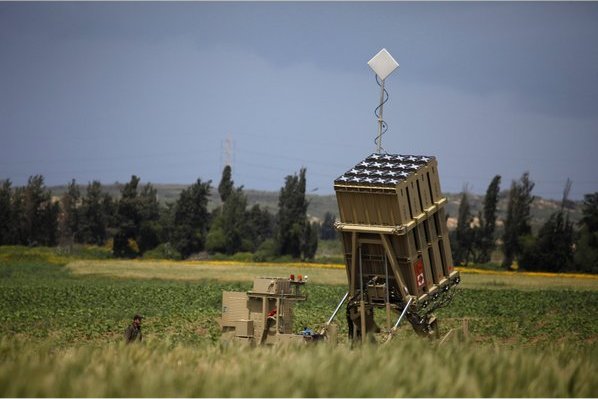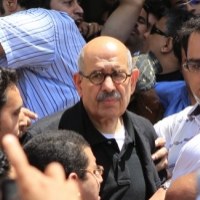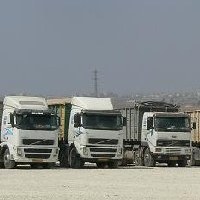![]()
Sat, April 9 2011 | DebkaFile

An Israeli soldier walks next to a launcher, part of the Iron Dome rocket shield system, near the southern city of Ashkelon. (Photo: Reuters)
Hamas Fires More Grads and Mortars at Southern Israeli Towns Saturday
A DebkaFile report:
Saturday, April 9, Hamas and its allies, acting now on Hizballah guidelines from Lebanon, fired 24 heavy Grad missiles and more than 50 mortars shells at seven southern Israeli towns in an expanding radius up to Palmahim in the north. Despite bomb shelters and home guard measures, 20 Israelis were injured or suffered shock.
After 17 Hamas and other commanders were targeted in 48 hours of Israel counter-attacks, Hamas requested a ceasefire through the UN. It came from the Islamist organization’s political echelons. Israel replied the request would only be addressed only if it came from Hamas military leaders, who rather than abating their rocket offensive on the Israeli population are intensifying it.
The Palestinian missile violence Saturday began before dawn with Grad missiles exploding north of Israel’s second main port city of Ashdod, south of Kiryat Gat and outside Ofakim. Sirens warning of a missile attack were heard in Gedera and Gan Yavneh. As a million Israeli civilians spent another day in bomb shelters, four Grad missiles landed in Ashkelon Saturday afternoon.
From Thursday, the innovative Iron Dome anti-missile system intercepted five of the Grad missiles aimed at Beersheba, Ashdod and Ashkelon. Early Saturday, as 25 Palestinian mortar shells hailed down on the Eshkol district, the IDF hit a car carrying three Hamas field commanders in Khan Younis. They were all killed. Debkafile’s military sources report that Israel’s defense chiefs are reassessing tactics in view of the newly ferocious level of Hamas belligerence under direction from Hizballah.
Debkafile reported earlier: Friday night, April 8, more than 60 Hamas and Jihad Islami mortar shells and missiles hit Israeli towns, villages and farms on the Israeli side of the Gaza border and injured a civilian. This heightened Israeli fury over Hamas’s attack on a school bus Thursday, April 7, using a sophisticated Cornet anti-tank missile for the first time. A 16-year old boy was critically wounded. This attack was followed by 50 Palestinian rockets and mortar rounds, a blitz which had not abated by Friday night despite constant Israeli counteraction.
Debkafile discloses the mounting violence has more than one objective: Hamas is trying to establish new rules for the conflict on advice and directives coming from its Lebanese ally, Hizballah, to step up its barrage on Israel by 25 percent. The IDF is forced to respond to the resulting escalation in kind.
Our intelligence sources report that Hamas was advised by Hizballah to blitz Israel into relinquishing the 500-meter deep security strip the IDF established inside the Gaza border when Palestinian fire on Israel continued after it was temporarily reduced by the 2009 Cast Lead operation.
Hizballah leaders are telling Hamas they should be able to bring their forward and firing positions right up to the Israeli border, a convenience enjoyed by Hizballah on the Lebanese-Israeli frontier ever since 2000 when Israel quit southern Lebanon.
The IDF is fighting to hold on to this buffer zone to keep Palestinian terrorists back from breaching the border for direct attacks in Israel. The soldiers keep Palestinian gunmen from accessing this strip of land and impose restrictions on Gazan farmers seeking to till their fields in a strip which covers 15 percent of the enclave’s arable land. (Farmers of the Eshkol district on the other side of the border are regularly targeted for attack.)
Hamas is threatening to raise the cross-border violence until Israeli troops pull back to the border. Its anti-tank missile attack on the school bus Thursday was the opening shot of its battle for the buffer zone.
The IDF’s tactics for countering Hamas aggression remain unchanged, except in scale: In the last 48 hours, Israeli helicopters, mortars, tanks and naval units have been pounding the Gaza Strip while Hamas releases barrages of dozens of missile and mortar attacks on villages and towns — practically without pause. Israeli civilians were told to stay close to bomb shelters in the days to come. Schools, road traffic, public transport and businesses will function intermittently.
Israeli military planners are still playing the familiar tit-for-tat game which never in the past stopped the aggression from Gaza. Nevertheless, debkafile’s military sources point to some notable differences in the current round.
The Iron Dome system designed in Israel to intercept short-range rockets was experimentally deployed in the important towns of Beersheba and Ashkelon this week. Friday, the system intercepted three missiles aimed at Ashkelon, although it caught only one of several Thursday.
The IDF importantly demonstrated it is fully capable of launching another major military campaign in the Gaza Strip. The broad scale of its land, sea and air reprisals since Thursday, April 7, was intended to remind Hamas and its allies, especially the Iranian-backed Jihad Islami, of the devastation wrought the enclave they rule by Israel’s 2009 Cast Lead operation.
A possible Cast Lead II was in the air after Israeli Prime Minister Binyamin Netanyahu said Thursday during a visit to Prague: Attacks on children cross a red line. Those who carry out such attacks should know that their blood is on their heads.”
On the other side of the ledger, the new rulers of Egypt are in the process of unraveling Hosni Mubarak’s peace relations with Israel — as debkafile has reported — and engaging in rapprochement with the Gaza and Damascus centers of the two radical Palestinian organizations.
Since the Israeli government has not adjusted its policies to the new developments, its military tactics are operating in a vacuum and will have little deterrent effect. The current upsurge of Hamas-Jihad aggression will therefore go on.
Debkafile’s military experts maintain that the tactics of massive firepower without ground operations have run their course. There is no way to wipe out the increasingly sophisticated heavy weapons arsenal Hamas has been allowed to amass from the air. So the half a million Israeli civilians of the Western Negev and the southern coastal towns must continue to live under their shadow instead of having normal lives. Often, many cannot make it to work and schools, places of business and traffic can operate only intermittently.
Since Thursday, IDF operations have been sweeping across a broad front in the Gaza Strip from the old air field at Dahaniyeh in the south up to the northern fringes of Gaza City.
In the south, Khan Younes and Deir al Balakh took the severest beating. The former went dark Thursday night after Israeli airborne and surface missiles knocked out the local electricity grid. In Deir Balakh, a Hamas base built deliberately near a hospital took an airborne rocket, a signal that all such facilities would no longer be immune from attack.
In the Gaza City region, Israeli helicopters, tanks and naval ships bombed two main Hamas military installations — Abu Jerad and Rantisi.
The Palestinians reported 10 killed, including the commander of missile operations at the Shati refugee camp, and scores wounded, thereupon loosing off 50 missiles and mortar rounds — as usual, against civilian locations. In Ashkelon, Iron Dome intercepted its first missile Thursday, but missed the rest — scoring a partial success
For the first time in three years, Hamas appealed to Cairo to broker a ceasefire. Israeli did not bother to respond since the rulers of Gaza have violated every agreed ceasefire in the past. Hamas reached out to the new Egyptian regime following its moves towards a rapprochement and a Palestinian diplomatic initiative.
Debkafile’s intelligence sources disclose that last week, the head of Egypt’s intelligence services Maj. Gen. Mourad Mowafi visited Damascus. He obtained permission from Syria’s beleaguered president Bashar Assad to meet Hamas’ political leader Khaled Meshaal and Abdullah Ramadan Salah of the Palestinian Jihad Islami and hand them an invitation to visit Cairo.
He then informed them that the new Egyptian leaders are willing to help negotiate Hamas’ reconciliation with Mahmoud Abbas’ Fatah on the following basis: Hamas would accept the two-state solution of the Palestinian-Israeli conflict but Egypt would not press for the second part of the formula endorsed by Washington and Israeli Prime Minister Netanyahu, namely that “the two states live alongside each other in peace and security.”
This amended formula would leave Hamas and the other radical Palestinian organizations free to continue their violent campaign of “resistance” against Israel while making peace with the rival Fatah and gaining a Palestinian state on the West Bank.
These days, Hamas is sure it is on a win-win course and has little to fear from stepping up its war on Israel until it gets what it wants.



 RSS
RSS

















#Hamas Fires More #Grads and #Mortars at Southern Israeli Towns Saturday | #Israel http://j.mp/eVm9VV
RT @CrethiPlethi: #Hamas Fires More #Grads and #Mortars at Southern Israeli Towns Saturday | #Israel http://j.mp/eVm9VV
RT @CrethiPlethi: #Hamas Fires More #Grads and #Mortars at Southern Israeli Towns Saturday | #Israel http://j.mp/eVm9VV